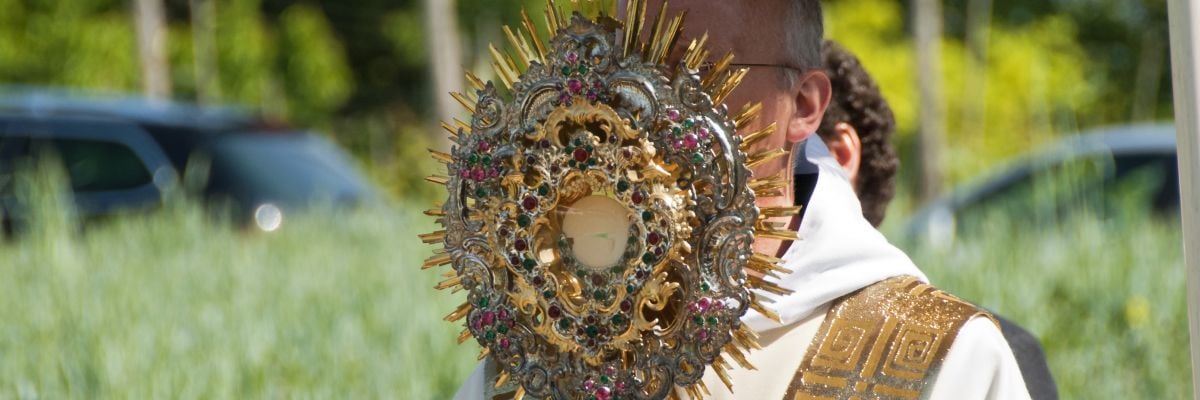
For years, the Lord God accompanied his Chosen People in a special way in the wilderness—a tabernacle that he overshadowed (Exod. 40:34-35)—which eventually became the most important part of the Temple in Jerusalem. At the heart of the tabernacle, in the holy of holies, God manifested his presence most intimately—and powerfully—atop the Ark of the Covenant, telling Moses,
And you shall put the mercy seat on the top of the ark. . . . There I will meet with you, and from above the mercy seat, from between the two cherubim that are upon the ark of the testimony, I will speak with you of all that I will give you in commandment for the people of Israel (Exod. 25:21-22).
Apart from Moses, with whom God sealed the Old Covenant (Exod. 24), only the high priest could go beyond the sacred veil into the holy of holies, and only once a year on the Day of Atonement (Yom Kippur). To do otherwise would result in death for the high priest or anyone else (Lev. 16:1–2; Num. 3:10; 18:7). And yet, in traveling through the wilderness to the Promised Land, God permitted the Ark to be brought outside the tabernacle to show forth his power.
For example, when the priests who carried the Ark dipped their feet into the River Jordan, the waters of the Jordan miraculously parted and the Israelites passed through the river bed—on dry ground, no less (Josh. 3:14-17). Soon after, the walls of Jericho would fall on the seventh day, after the people had circled them seven times with the Ark (Josh. 6). Earlier in salvation history, a group went up to the hill country God had promised Israel, but they did so without the Ark, and they were defeated by the Amalekites and the Canaanites (Num. 14:39-45). The Philistines later discovered that capturing the Ark from Israel was a short-lived celebration (1 Sam. Ch. 5,6).
Where is the power of the Ark in the New Covenant, including the present? If the face-melting blast portrayed in Raiders of the Lost Ark isn’t quite available to us, how can we bring God into battle today amidst a culture of death that seeks to destroy the Catholic Church? In an important sense, the Blessed Mother is the New Ark, because in her womb “the Word became flesh” (John 1:14), Jesus the God-man who, in offering himself for our sins, tears in two—from top to bottom—the Temple curtain that enclosed the holy of holies, symbolically demonstrating that mankind could now draw near for intimate communion with the Almighty (Matt. 27:51).
Jesus continues to be with us, especially in the Holy Eucharist, which means that every church tabernacle, wherein our Lord resides under the appearances of bread and wine in consecrated Hosts, is a New Covenant analogue to the holy of holies.
The reverence the ancient Israelites had toward the holy of holies should give us pious pause in how we approach our Eucharistic Lord, especially in receiving him in Holy Communion, lest we “eat and drink judgment upon” ourselves, as St. Paul warns (1 Cor. 11:27-30).
Given the great power of the Blessed Sacrament, how can we marshal the might of this great divine gift in our troubled society beyond our personal witness? St. Paul also says that our ultimate fight is not “against flesh and blood,” but rather “the spiritual hosts of wickedness in the heavenly places” (Eph. 6:12).
In other words, we are foolish not to take full advantage of the offensive weapons God gives us in our battle in advancing his kingdom, namely himself, and in the preeminent sacramental way he promised to be with us until he returns at his Second Coming to judge the living and the dead (see Matt. 28:20).
In raising awareness about the Blessed Sacrament’s power and combating the forces of evil in the process, I suggest we begin with young adult Catholics, the age group that polls show are least likely among Catholics to participate in Sunday Mass.
A good place to start is where young adults gather annually in great numbers, unwittingly collaborating with the forces of evil in a vain attempt at self-fulfillment via alcohol, drugs, and sexual misbehavior. That is, spring break, which begins later this month and lasts for several weeks at numerous sunny locales.
As with the Ark, wonderful things can happen when we bring Catholics and others into protective proximity of Christ’s Real Presence: “For though we live in the world we are not carrying on a worldly war,” St. Paul proclaims, “for the weapons of our warfare are not worldly but have divine power to destroy strongholds” (2 Corinthians 10:3-4).
Local dioceses and parishes could get permits to have Eucharistic processions on the streets and/or sidewalks near the beaches and other locations where young people congregate, and schedule associated Eucharistic adoration—preferably with exposition—at nearby churches. And dioceses with spring-break destinies could inform dioceses elsewhere to let their young people know—through parish announcements and texts—about these edifying resources when they make their winter-break sojourns.
“The Gospel is for everyone!” Pope Francis proclaimed early in his pontificate. “We must go there! . . . All the peripheries, all the crossroads on the way: go there.”
At the heart of the Gospel is an intimate encounter with Jesus, and what better way to encounter Jesus than through the intimacy of his Real Presence? Eucharistic adoration has long been a featured and fruitful part of World Youth Day celebrations, and there are no impediments for Catholics and non-Catholics to connect with our Eucharistic Lord via adoration, which can lay the groundwork for fruitful reception of Holy Communion (see 1 Cor. 11:27-30).
Indeed, such spring-break efforts could foster greater participation in the sacraments, especially Confession and the celebration of the Eucharistic Sacrifice at Mass, “the source and summit of the Christian life” (CCC 1324).
Several years ago, Catholic young adults stepped forward at Harvard University, as the power of the Blessed Sacrament shined forth in a twilight procession to counter a scheduled Black Mass. The procession “stretched for several blocks,” veteran Catholic journalist Phil Lawler recalls. “At Harvard, St. Paul’s church was packed, with many people standing outside the doors, for an hour of adoration ending in Benediction of the Blessed Sacrament.”
“A Boston Globe photographer captured an image of the crowded church, and several moving shots of the procession,” Lawler adds. “The young people kneeling on the stone steps, the reverent hush in the church, the booming resonance of the Tantum Ergo all radiated the vigor and joy of the Catholic faith. . . . We didn’t merely win a battle in the spiritual combat; we launched an offensive.”
Given the state of our Church and society, especially among Catholic young adults and their peers, the scope of that offensive needs to be widened dramatically. Spring break is an ideal time and place to bring our Eucharistic Lord to the battlefield, and similar forays can follow in due time.



